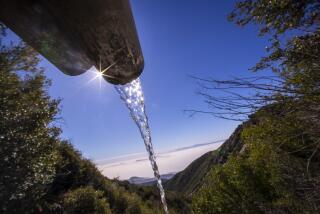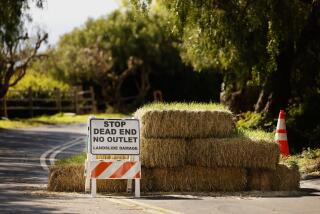Pipe to be removed for testing as long oil spill cleanup takes shape
Reporting from Santa Barbara — The owners of a pipeline that burst and spilled up to 101,000 gallons of crude along the Santa Barbara County coast expect to remove the ruptured section Thursday.
Federal regulators say the longterm cleanup is just beginning with more than 10,000 gallons of oily water recovered from the ocean’s surface. Responders are now using sonar and diver teams to focus on finding and cleaning oil that has pooled under water.
UC Santa Barbara divers have observed collections of oil droplets, as well as bundles of pillow-sized oil and seaweed, at four locations about 150 yards off Refugio State Beach, said Rick McMichael, director of pipeline operations for Plains All American Pipeline.
The U.S. Environmental Protection Agency and the U.S. Coast Guard issued a federal order Wednesday to the company, with timelines and cleanup requirements established under the federal Clean Water Act.
Officials say the move will ensure a thorough restoration of ocean waters and shoreline fouled by the May 19 spill. Up to 21,000 gallons of crude went downhill from the spill site into a culvert under U.S. 101 then shot out onto bluffs and into the Pacific.
“There may not be oil on the beach like there was on the first few days, but there is still a problem,” said Jared Blumenfeld, administrator for the U.S. Environmental Protection Agency’s Pacific Southwest region, at a news conference Wednesday. “That problem needs to be cleaned up. The oil all needs to be removed.”
By June 6, the company must submit a work plan and detail how it will sample the air, water, rocks and soil. Plains will comply with the order, company officials said.
U.S. Coast Guard Capt. Jennifer Williams said the latest survey of coast showed 4.6 miles of shoreline were heavily affected by the spill while 6 miles were moderately affected and 8.9 miles were lightly affected.
Scientists with UC Santa Barbara and the National Oceanic and Atmospheric Administration are working to “fingerprint” the tar balls and globs of oil along the beaches to determine if they are from the spill or natural seepage.
Typically, there can be up to 50 barrels of natural seep a day, said Thomas Cullen, an administrator for the California Office of Spill Prevention and Response.
Plains official Patrick Hodgins said workers are expected to cut out the ruptured section of pipe Thursday and send it to a third-party metallurgist to determine the condition of the pipe when it failed.
For more California news, follow @jpanzar.
More to Read
Sign up for Essential California
The most important California stories and recommendations in your inbox every morning.
You may occasionally receive promotional content from the Los Angeles Times.










